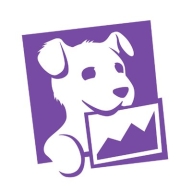

Datadog and Mezmo are competing in the monitoring and analytics solutions category. Datadog appears to have an upper hand in scalability and integration possibilities, while Mezmo is favored for customization and flexibility.
Features: Datadog provides real-time monitoring, extensive cloud integrations, and automation capabilities. Mezmo offers customization, diverse log management, and flexibility, appealing to those needing tailored solutions.
Ease of Deployment and Customer Service: Datadog ensures a seamless deployment with strong customer support, recognized for its responsive assistance. Mezmo presents a flexible deployment model, with customer service focusing on custom solutions and engagement.
Pricing and ROI: Datadog's pricing may be higher, supporting large-scale operations with complex integration needs and offering worthwhile ROI. Mezmo presents cost-effective solutions with lower upfront costs and competitive ROI, attracting those prioritizing budget-friendly options.
| Product | Market Share (%) |
|---|---|
| Datadog | 6.6% |
| Mezmo | 0.4% |
| Other | 93.0% |

| Company Size | Count |
|---|---|
| Small Business | 80 |
| Midsize Enterprise | 46 |
| Large Enterprise | 95 |
Datadog integrates extensive monitoring solutions with features like customizable dashboards and real-time alerting, supporting efficient system management. Its seamless integration capabilities with tools like AWS and Slack make it a critical part of cloud infrastructure monitoring.
Datadog offers centralized logging and monitoring, making troubleshooting fast and efficient. It facilitates performance tracking in cloud environments such as AWS and Azure, utilizing tools like EC2 and APM for service management. Custom metrics and alerts improve the ability to respond to issues swiftly, while real-time tools enhance system responsiveness. However, users express the need for improved query performance, a more intuitive UI, and increased integration capabilities. Concerns about the pricing model's complexity have led to calls for greater transparency and control, and additional advanced customization options are sought. Datadog's implementation requires attention to these aspects, with enhanced documentation and onboarding recommended to reduce the learning curve.
What are Datadog's Key Features?In industries like finance and technology, Datadog is implemented for its monitoring capabilities across cloud architectures. Its ability to aggregate logs and provide a unified view enhances reliability in environments demanding high performance. By leveraging real-time insights and integration with platforms like AWS and Azure, organizations in these sectors efficiently manage their cloud infrastructures, ensuring optimal performance and proactive issue resolution.
Today’s enterprises must manage a massive amount of machine data. They require a platform that enables engineering teams to deliberately route and store structured and unstructured data for different teams with unique use cases. Legacy platforms weren’t made for this moment.
Mezmo, formerly LogDNA, lets organizations ingest, process, route, analyze, and store all of their log data. Purpose-built for modern engineering teams—including developers, SREs, IT Operations, and Security Engineers—the Mezmo platform is trusted by thousands of companies for SaaS, cloud, and hybrid applications.
We monitor all Application Performance Monitoring (APM) and Observability reviews to prevent fraudulent reviews and keep review quality high. We do not post reviews by company employees or direct competitors. We validate each review for authenticity via cross-reference with LinkedIn, and personal follow-up with the reviewer when necessary.